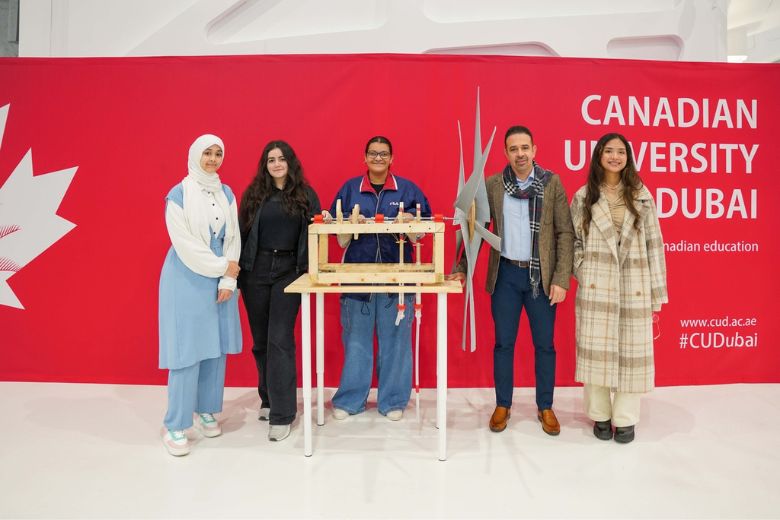An all-girl team of first-year engineering students from Canadian University Dubai (CUD) has developed an award-winning solution for the sustainable transportation of water. The wind-powered lifting system was recognised for its efficient, innovative design, winning first place in a recent competition staged by the global industry body, the Institute of Electrical and Electronics Engineers (IEEE).
The team of seventeen-year-olds, Danica Reyes and Jana Nozamy, and eighteen-year-olds Marwa Khaled and Somayya Khaled, joined forces just a few weeks into their degree programme at CUD to embark on the engineering design project. The challenge was to build a cost-effective and efficient wind-powered wheel, capable of lifting water between two levels without the use of electricity.
All-girl group of first-year engineering students awarded by industry body
Explaining the purpose behind the project, Danica said, “The idea was to create a solution for water transportation in rural areas and other places with limited infrastructure. The prototype we developed combined modern engineering practices with an ancient pumping mechanism driven by wind power. The system demonstrates how centuries-old techniques can be combined with innovative approaches to produce sustainable energy.”
Speaking about the development process, Marwa explained: “We were all just starting out on our mechatronics degree and had to develop a whole new range of skills in a very short space of time. From product design to 3D printing and precision cutting, we had an exciting and challenging hands-on experience that helped us learn a lot about the practice of engineering very early in our studies.”
The team earned first place in the IEEE competition for pumping the highest volume of water
Somayya continued: “We went through a number of different ideas in designing the propeller blades to optimise the wind power and also in developing the pump action to increase the volume of water transferred. We were determined to get the best possible output so there was a lot of trial and error, and we tested four alternative approaches before creating the final solution.”
Featuring a unique combination of advanced technology in the form of 3D-printed components, alongside simple household items such as a wooden breadboard, the prototype successfully and efficiently pumped water in both upward and downward directions. The team earned first place in the IEEE competition for pumping the highest volume of water, combined with their creative design approach.
Speaking about their success Jana said: “As an all-girl team we are very proud that our project stood out at a competitive industry-led event. We feel empowered by this win to challenge the stereotypes that we’ve all encountered around women in science and technology, and we will continue to follow our passion for engineering and encourage other girls to do the same.”
Mentoring the team through the competition was Associate Professor, Dr Ahmed Al-Gindy, who added: “I was extremely impressed with the creativity the team showed in sourcing and adapting the raw materials and the excellent technical skills they demonstrated at such an early stage in their university studies. We want to encourage even more girls to participate in STEM subjects and this team has scored a remarkable achievement that will be an inspiration to other aspiring female engineers.”





